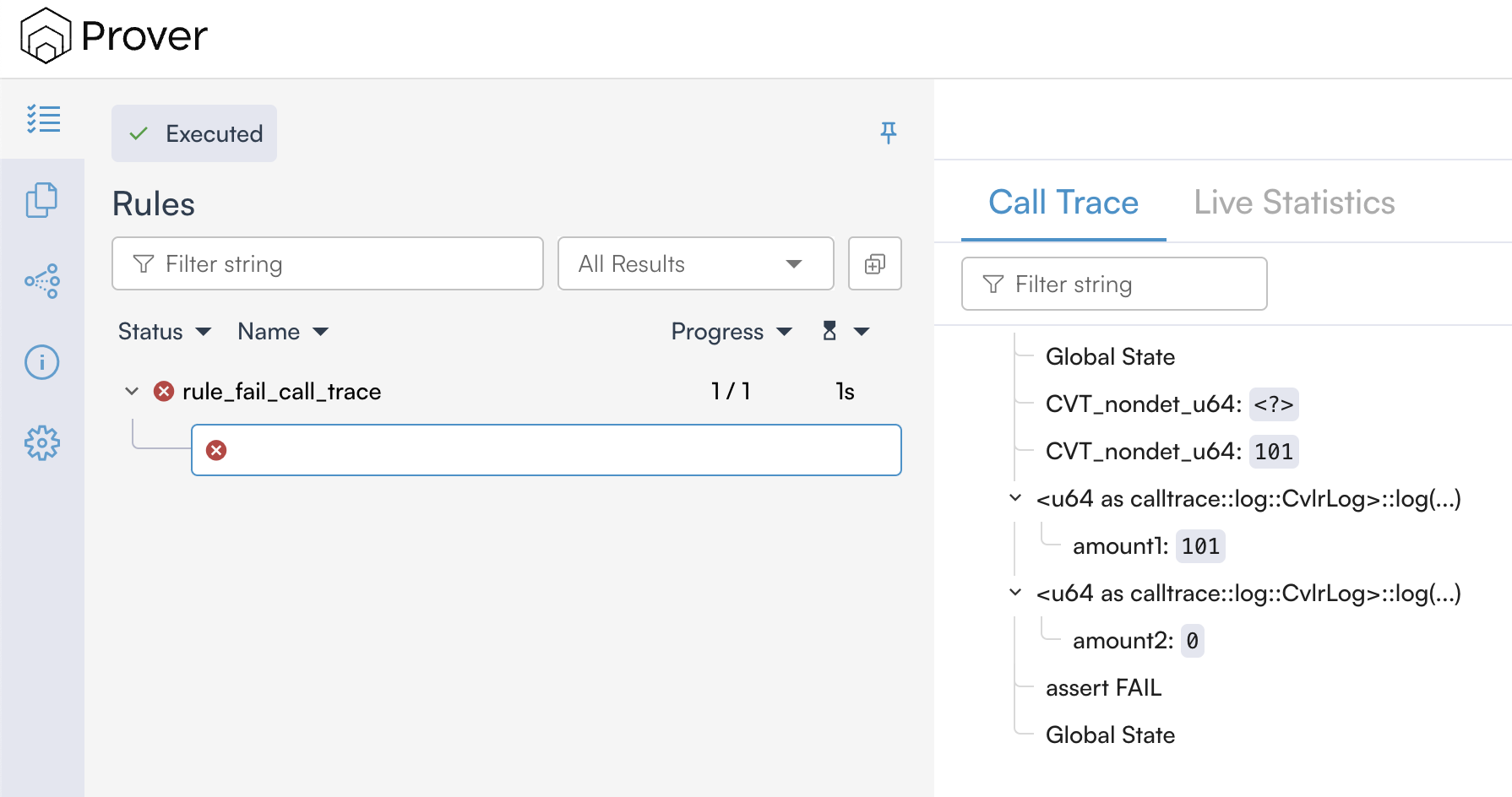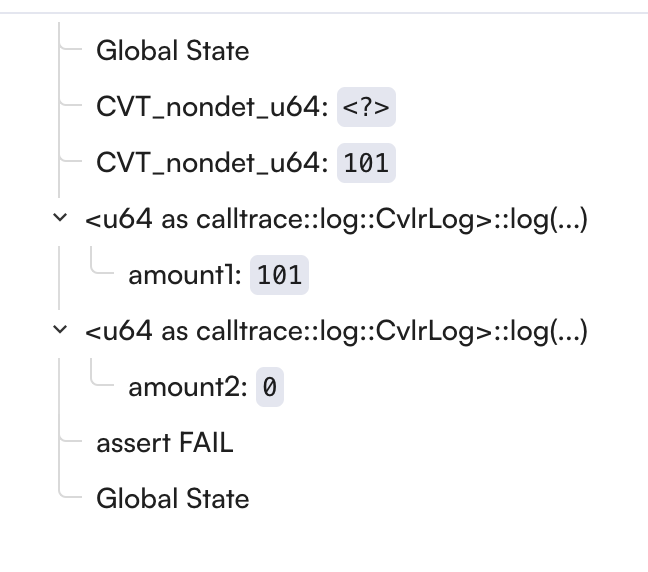Understanding Prover Output for Solana Programs
Overview
This guide explains how to interpret verification results from the Certora Prover for Solana programs. It’s designed for developers familiar with Solana/Rust development and formal verification concepts.
Verification Tasks
A verification task consists of one or more rules that verify specific properties of your Solana program. Each rule contains at least one of the following:
Assert statements
cvlr_assert!Satisfy statements
cvlr_satisfy!
Understanding Rule Results
Assert Statements
When using cvlr_assert, the Prover attempts to prove that the assertion holds true for all possible program states. For example:
cvlr_assert!(amount > 10);
The Prover will return one of two results:

PASSED: The assertion is proven true for all possible computation paths and initial values

FAILED: A counterexample (CEX) was found, i.e a starting state and computation path that violates the assertion. The Prover stops at the first counterexample found, even if multiple counterexamples exist
Satisfy Statements
cvlr_satisfy statements verify that a certain condition is reachable. For example:
cvlr_satisfy!(amount > 10);
The results can be:
PASSED: At least one execution path exists where the condition is true
FAILED: The condition is unreachable under any execution path
Analyzing Counterexamples
When a rule fails, the Prover generates a counterexample showing the execution path that led to the failure. Counterexamples can be:
Valid: Indicating a genuine bug in the code
Spurious: Resulting from over-approximation of possible program states
Call Trace Analysis

The call trace provides detailed information about the execution path. Here’s how to interpret it:
Nondeterministic Values
Appear at the beginning of the trace
Represent the starting state which leads to a violation
Format:
CVT_nondet_u64: <value>
Variable Values
The values of variables can be printed using the
clog!macroExample:
let x: u64 = nondet(); clog!(x);
Method Calls
Automatically logged
Show the sequence of function calls
To see parameter values, they have to be logged using
clog!macro
Let’s look at a concrete example
#[rule]
pub fn rule_fail_call_trace() {
let amount1: u64 = nondet();
let amount2: u64 = nondet();
cvlr_assume!(amount1 > 100);
cvlr_assume!(amount2 != 10);
clog!(amount1, amount2);
cvlr_assert!(amount1 < 100);
cvlr_assert!(amount2 < 100);
}
When this rule fails, the Prover generates a counterexample that looks like this:

Let’s analyze this counterexample:
Nondet Values:
The Prover chose
101foramount1and implicitly0foramount2These values are chosen to demonstrate the violation of our assertions
<?>means that the value is not important for the counterexample
Variable States:
amount1is 101, which satisfies our assumptioncvlr_assume!(amount1 > 100)amount2is 0, which satisfies our assumptioncvlr_assume!(amount2 != 10)
Assertion Failure:
The assertion
cvlr_assert!(amount1 < 100)fails because we have a contradiction:We previously assumed
amount1 > 100But then we assert
amount1 < 100
This is impossible to satisfy, hence the counterexample
Rule Sanity Checking
To ensure rules aren’t passing vacuously (due to contradictory assumptions), add sanity checking to your configuration:
{
"rule_sanity": "basic"
}
This adds an implicit cvlr_satisfy!(true) at the end of each rule. If this assertion is unreachable, it confirms that:
The assumptions are not contradictory
The successful verification of the rule is meaningful
Common Sanity Check Results
Sanity Check PASSED: The desired outcome - confirms rule isn’t vacuously true
Sanity Check WARNING: Warning sign - indicates contradictory assumptions
See Rule Sanity Checks for more details.
Best Practices
Always enable rule sanity checking in your configuration
Review full call traces when investigating failures
Validate counterexamples against your program’s expected state space
Advanced Topics
Analyzing Functions Complexity
The Certora Solana Prover offers the Live Statistics panel to analyze the complexity of individual functions.
The Live Statistics provide information, for instance, about the number of paths of a function body which may help when having difficult to solve rules.
Observe that the Live Statistics panel is affected by the solanaMinSizeForCalltrace option.
Functions with a size smaller than this threshold, measured by the number of TAC commands they correspond to, will not be displayed in the Live Statistics panel.
Refer to the Timeouts section for further information.
Over-approximation Detection
When analyzing counterexamples, consider:
Initial state feasibility: Is the starting state reachable for the code you’re analyzing?
Transaction sequence validity: Does the computation path make sense? Did you overlook a certain scenario?
State transition legitimacy: Do the values throughout the computation match? Are the parameters of your rule changing as expected?
If any seem impossible in your actual program, the counterexample might be due to over-approximation.